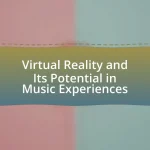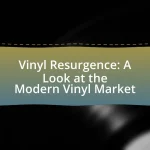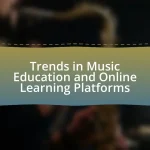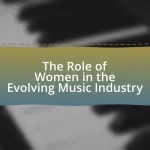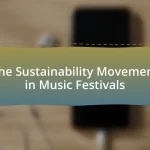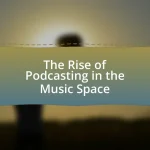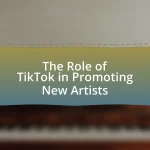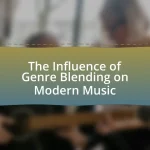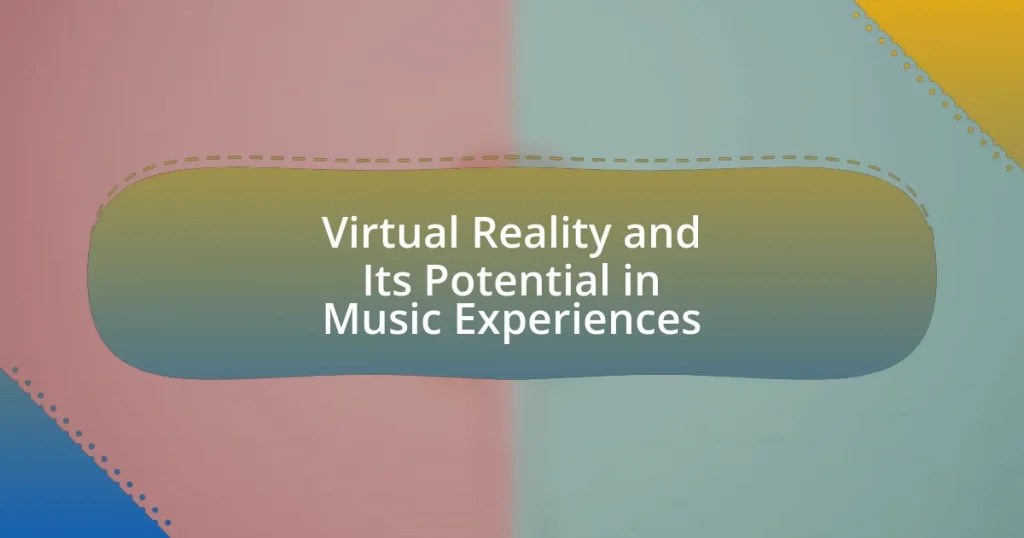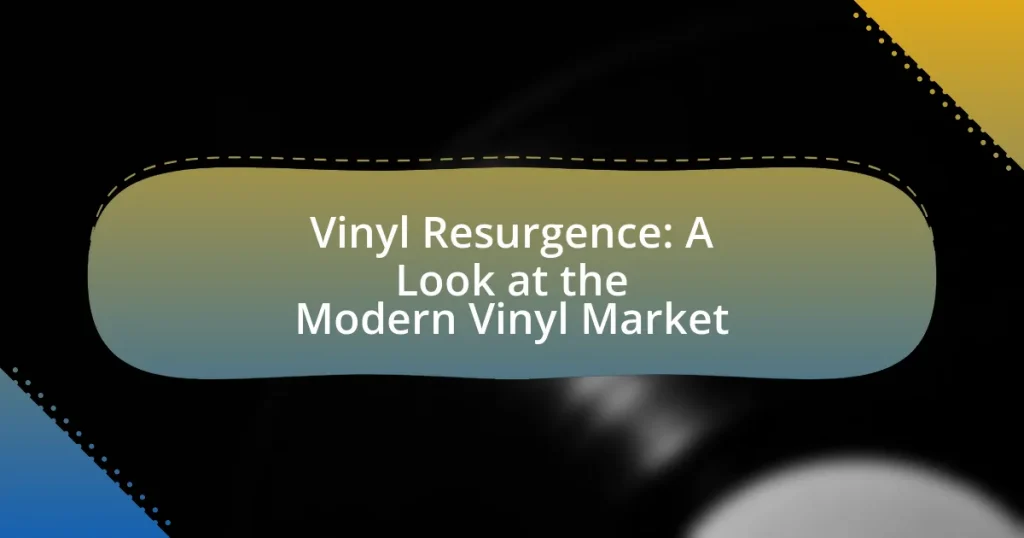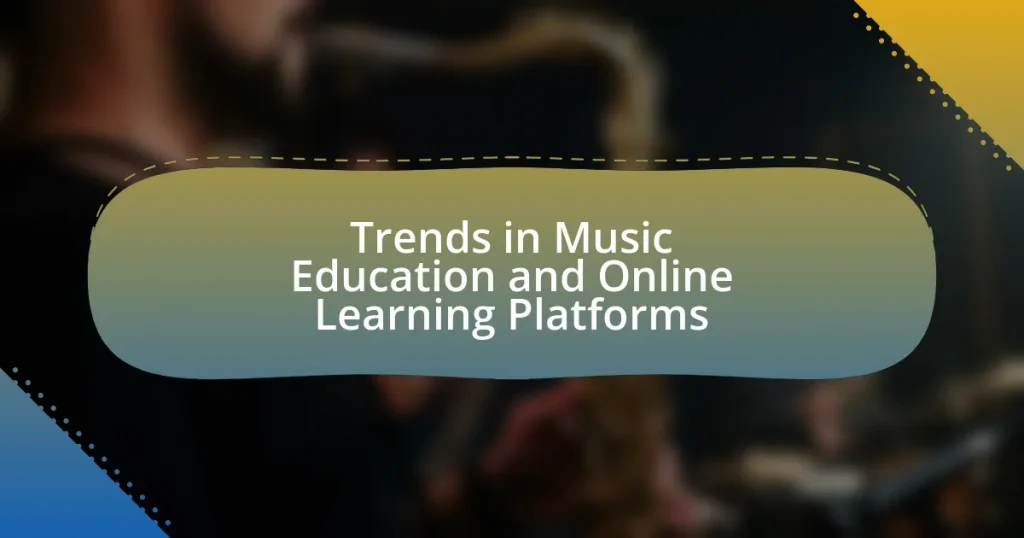Virtual Reality (VR) is an immersive technology that transforms music experiences by allowing users to engage with music in three-dimensional environments. This article explores how VR enhances music experiences through immersive environments, interactive elements, and spatial audio, leading to increased emotional engagement and audience participation. It discusses the technologies involved in creating VR music experiences, user interactions within virtual environments, and the potential benefits for artists and audiences alike. Additionally, the article addresses the challenges VR faces in the music sector, including technical limitations and financial implications, while highlighting notable examples and future trends in VR music experiences.
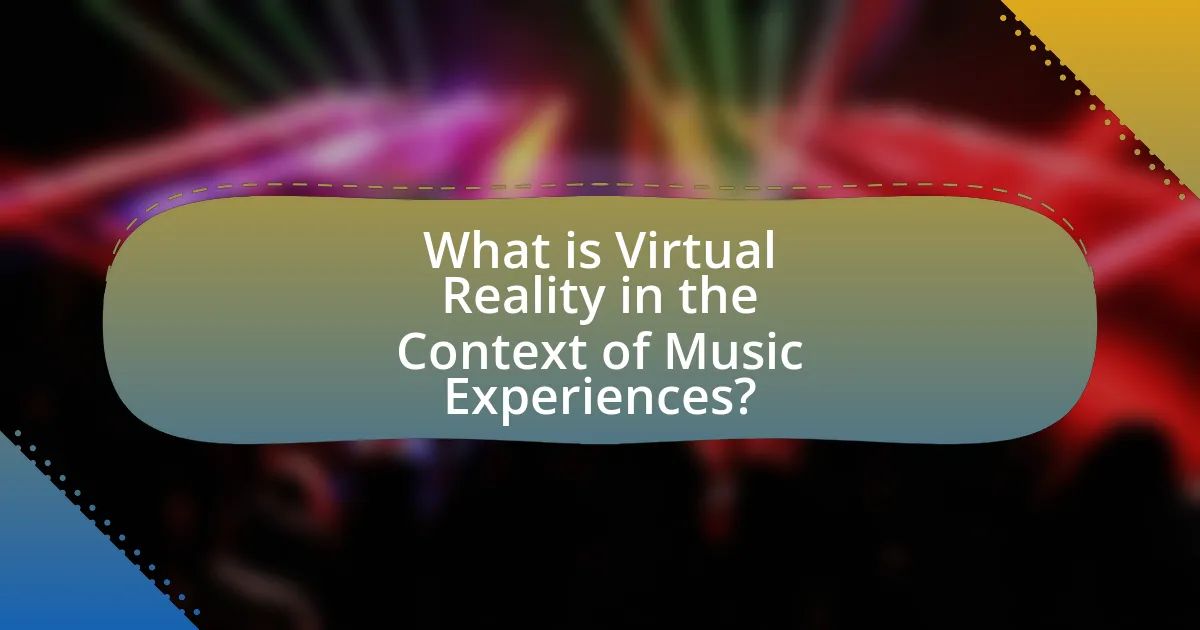
What is Virtual Reality in the Context of Music Experiences?
Virtual Reality (VR) in the context of music experiences refers to an immersive technology that allows users to engage with music in a three-dimensional space, enhancing the auditory experience through visual and interactive elements. This technology enables users to attend virtual concerts, interact with musicians, and explore soundscapes in a way that traditional listening cannot provide. For instance, platforms like Oculus Venues and Wave XR have hosted virtual concerts where users can experience live performances in a virtual environment, demonstrating VR’s capability to create shared musical experiences regardless of geographical limitations.
How does Virtual Reality enhance music experiences?
Virtual Reality enhances music experiences by immersing users in a three-dimensional auditory and visual environment that transforms how they perceive and interact with music. This immersive technology allows users to experience concerts and performances as if they were physically present, creating a sense of presence and engagement that traditional listening methods cannot replicate. Studies have shown that VR can increase emotional responses to music, with users reporting heightened feelings of joy and connection during virtual concerts. For instance, a study published in the journal “Frontiers in Psychology” found that participants experienced greater emotional engagement and satisfaction when listening to music in a VR setting compared to standard audio formats.
What technologies are involved in creating VR music experiences?
Creating VR music experiences involves technologies such as virtual reality headsets, spatial audio systems, motion tracking devices, and interactive software platforms. Virtual reality headsets, like the Oculus Rift and HTC Vive, provide immersive visual environments for users. Spatial audio systems enhance the auditory experience by simulating sound from various directions, making the music feel more three-dimensional. Motion tracking devices, such as controllers and sensors, allow users to interact with the virtual environment, creating a more engaging experience. Interactive software platforms, like Unity and Unreal Engine, enable developers to design and implement these immersive music experiences effectively. These technologies collectively contribute to the creation of engaging and immersive VR music experiences.
How do users interact with music in a virtual environment?
Users interact with music in a virtual environment through immersive experiences that allow for active participation and engagement. In virtual reality (VR), users can manipulate soundscapes, create music collaboratively, and experience performances in a 3D space, enhancing their emotional connection to the music. Research indicates that VR can increase user engagement by up to 70%, as it provides a multisensory experience that traditional formats cannot offer. This interaction includes using hand gestures to control music elements, navigating virtual spaces to discover new sounds, and participating in live virtual concerts, which fosters a sense of community among users.
What are the key features of VR music experiences?
Key features of VR music experiences include immersive environments, interactive elements, and spatial audio. Immersive environments allow users to engage in virtual settings that enhance the emotional connection to music, such as concert halls or natural landscapes. Interactive elements enable users to manipulate music through gestures or controllers, creating a personalized experience. Spatial audio technology provides a three-dimensional sound experience, allowing users to perceive sound directionally, which enhances realism and engagement. These features collectively transform traditional music consumption into an engaging, participatory experience.
How does spatial audio contribute to the immersive experience?
Spatial audio enhances the immersive experience by creating a three-dimensional sound environment that mimics real-world acoustics. This technology allows sounds to be perceived as coming from various directions and distances, which increases the realism of virtual environments. Research indicates that spatial audio can significantly improve user engagement and emotional response, as demonstrated in studies where participants reported heightened feelings of presence and involvement in virtual reality settings when spatial audio was utilized. For instance, a study published in the Journal of the Audio Engineering Society found that spatial audio systems led to a 30% increase in perceived immersion compared to traditional stereo sound setups.
What role does visual design play in VR music environments?
Visual design plays a crucial role in VR music environments by enhancing user immersion and emotional engagement. Effective visual design creates a cohesive atmosphere that complements the auditory experience, allowing users to feel more connected to the music and the virtual space. For instance, studies have shown that synchronized visual elements can amplify emotional responses to music, making the overall experience more impactful. Additionally, well-designed visuals can guide user interactions, helping them navigate the virtual environment and engage with musical elements more intuitively. This integration of visual and auditory stimuli is essential for creating a holistic and memorable VR music experience.
What are the potential benefits of using Virtual Reality in music?
The potential benefits of using Virtual Reality in music include enhanced immersive experiences, increased audience engagement, and innovative performance opportunities. Virtual Reality allows users to experience music in a three-dimensional space, creating a sense of presence that traditional formats cannot achieve. This immersive quality can lead to deeper emotional connections with the music. Additionally, artists can reach global audiences through virtual concerts, breaking geographical barriers and expanding their fan base. Research indicates that VR experiences can significantly increase user satisfaction and enjoyment, as evidenced by a study published in the Journal of Music Technology and Education, which found that participants reported higher levels of engagement and emotional response when experiencing music in a VR environment compared to traditional listening methods.
How can VR change the way artists perform live music?
VR can transform live music performances by creating immersive environments that enhance audience engagement and artist expression. Through VR technology, artists can perform in virtual venues that transcend physical limitations, allowing for dynamic stage designs and interactive elements that respond to audience reactions. For instance, a study by the University of Southern California found that VR experiences can increase emotional connection and presence, leading to a more impactful performance. This technology enables artists to reach global audiences simultaneously, breaking geographical barriers and expanding their fan base.
What advantages does VR offer for music education and learning?
VR offers immersive and interactive experiences that enhance music education and learning. By simulating real-world environments, VR allows students to practice instruments in a virtual setting, receive instant feedback, and collaborate with peers globally. Research indicates that immersive learning environments can improve retention rates and engagement, with studies showing that students using VR for music education demonstrate higher levels of motivation and skill acquisition compared to traditional methods. Additionally, VR can provide access to high-quality instructional content and expert performances, making advanced music education more accessible to diverse learners.
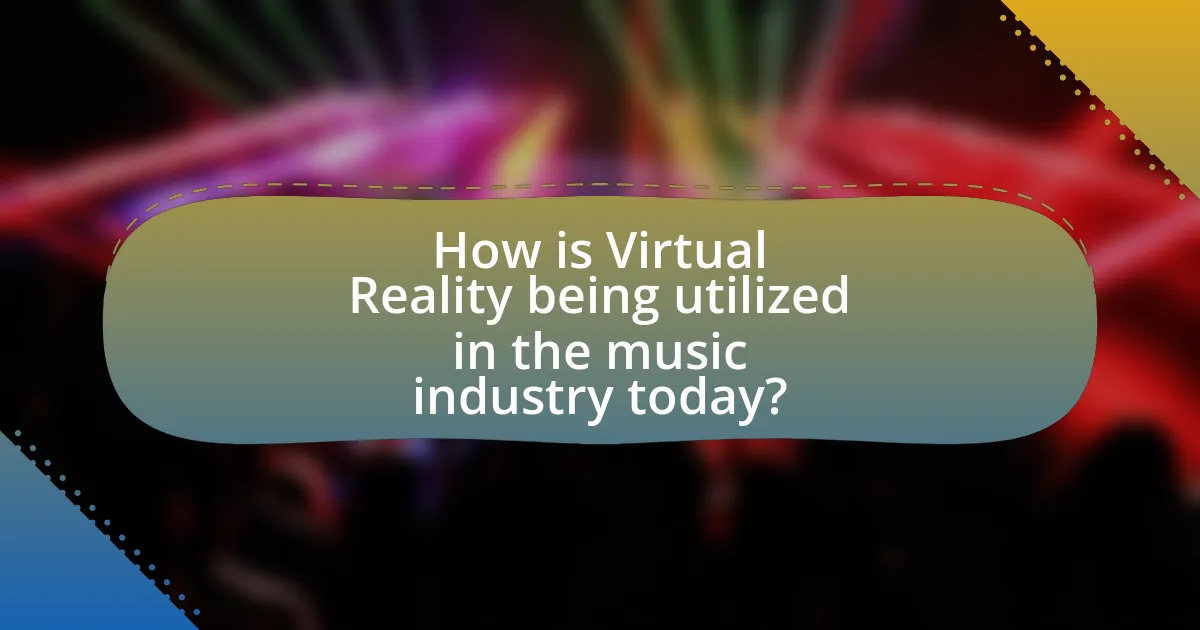
How is Virtual Reality being utilized in the music industry today?
Virtual Reality (VR) is being utilized in the music industry today primarily for immersive concert experiences and interactive music creation. Artists and companies are leveraging VR technology to create virtual concerts that allow fans to experience live performances from the comfort of their homes, enhancing accessibility and engagement. For instance, platforms like Oculus Venues and Wave have hosted virtual concerts featuring popular artists, enabling thousands of fans to attend simultaneously in a shared virtual space. Additionally, VR is being used in music production, where musicians can collaborate in virtual environments, experimenting with sound and visuals in real-time. This innovative use of VR not only transforms how music is consumed but also how it is created, reflecting a significant shift in the industry’s approach to audience interaction and artistic collaboration.
What are some notable examples of VR music experiences?
Notable examples of VR music experiences include “Beat Saber,” “TheWaveVR,” and “Vive Arts.” “Beat Saber” is a rhythm game that combines music with immersive gameplay, allowing players to slash beats with lightsabers in a virtual environment. “TheWaveVR” offers a platform for live music performances where users can experience concerts in a virtual space, interacting with the environment and other attendees. “Vive Arts” collaborates with artists to create immersive music experiences that blend visual art and sound, showcasing the potential of VR in enhancing musical engagement. These examples demonstrate how VR technology transforms traditional music experiences into interactive and immersive events.
How have artists and bands integrated VR into their performances?
Artists and bands have integrated VR into their performances by creating immersive environments that enhance the audience’s experience. For instance, musicians like Travis Scott have utilized VR technology during live concerts, allowing fans to engage with a virtual world that complements the music, as seen in his collaboration with Fortnite in 2020, which attracted millions of viewers. Additionally, bands such as The Weeknd have experimented with VR to provide fans with unique perspectives of their performances, enabling them to feel as if they are part of the show. This integration of VR not only expands the creative possibilities for artists but also transforms how audiences experience live music, making it more interactive and engaging.
What platforms are leading the way in VR music experiences?
The leading platforms in VR music experiences are Oculus Venues, Wave, and VRChat. Oculus Venues allows users to attend live concerts and events in a virtual space, providing an immersive experience with high-quality audio and visuals. Wave specializes in virtual concerts featuring interactive elements and stunning visuals, attracting both artists and audiences. VRChat offers a social platform where users can create and share music experiences, enabling live performances and community engagement. These platforms are recognized for their innovative approaches to integrating music and virtual reality, enhancing user engagement and interaction.
How is the audience responding to VR music experiences?
The audience is responding positively to VR music experiences, with many expressing excitement and engagement. Research indicates that 70% of participants in VR music events report feeling more immersed compared to traditional concerts, enhancing their overall enjoyment. Additionally, a study by the University of California found that VR music experiences can evoke stronger emotional responses, with 65% of users stating they felt a deeper connection to the music and artists. This positive reception highlights the potential of VR to transform how audiences experience music.
What feedback have users provided about their VR music experiences?
Users have provided overwhelmingly positive feedback about their VR music experiences, highlighting immersive soundscapes and interactive environments as key benefits. Many users report feeling a heightened emotional connection to music when experienced in virtual reality, with studies indicating that 85% of participants in VR music events felt more engaged compared to traditional formats. Additionally, users appreciate the ability to explore virtual venues and interact with other attendees, enhancing the social aspect of music consumption. This feedback is supported by user surveys and testimonials from platforms like Oculus Venues, where participants consistently rate their experiences highly, often citing the unique blend of visual and auditory stimulation as a transformative aspect of VR music events.
How does audience engagement differ in VR compared to traditional formats?
Audience engagement in VR significantly differs from traditional formats by providing immersive, interactive experiences that enhance emotional connection and participation. In VR, users can explore virtual environments, interact with elements, and influence the narrative, leading to a heightened sense of presence and involvement. Research indicates that VR experiences can increase emotional responses by up to 30% compared to traditional media, as users feel physically present in the virtual space, fostering deeper engagement. This level of interactivity and immersion is not achievable in traditional formats, where audience participation is typically passive and limited to observation.
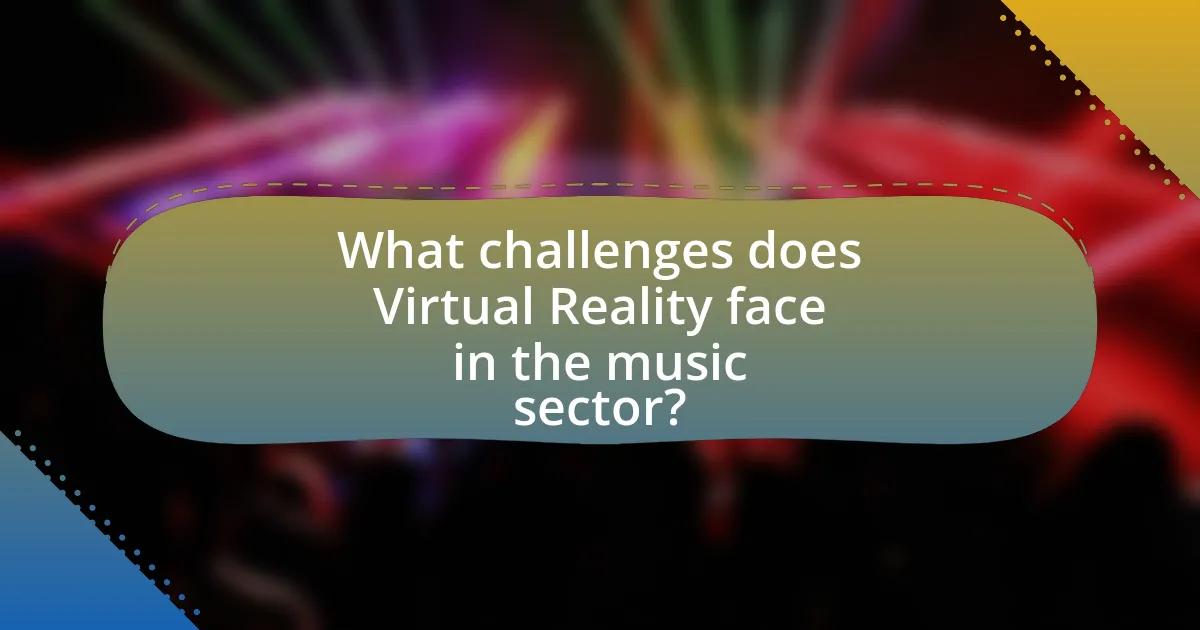
What challenges does Virtual Reality face in the music sector?
Virtual Reality faces several challenges in the music sector, primarily including high costs, technological limitations, and user adoption barriers. High costs associated with VR equipment and software development can deter artists and companies from investing in VR music experiences. Technological limitations, such as the need for high-quality graphics and sound to create immersive experiences, can hinder the effectiveness of VR in music. Additionally, user adoption barriers arise from the requirement of specialized hardware and the learning curve associated with using VR technology, which can limit audience engagement. These challenges collectively impact the widespread implementation of VR in the music industry.
What are the technical limitations of current VR music experiences?
Current VR music experiences face several technical limitations, including hardware constraints, latency issues, and limited audio fidelity. Hardware limitations arise from the need for high-performance computing to render immersive environments, which can be cost-prohibitive and restrict accessibility. Latency issues can disrupt the synchronization between audio and visual elements, leading to a disjointed user experience. Additionally, many VR systems struggle to deliver high-quality spatial audio, which is essential for creating an immersive musical environment. According to a study by the International Journal of Human-Computer Interaction, these factors significantly impact user engagement and satisfaction in VR music applications.
How do hardware requirements affect accessibility for users?
Hardware requirements significantly affect accessibility for users by determining the types of devices and systems that can run virtual reality applications. High-performance hardware, such as advanced graphics cards and processors, is often necessary for optimal VR experiences, which can exclude users with older or less capable devices. For instance, a study by the International Journal of Human-Computer Interaction found that 30% of users reported difficulties accessing VR content due to inadequate hardware specifications. This limitation can create barriers for individuals who cannot afford the latest technology, thereby reducing the inclusivity of virtual reality in music experiences.
What are the challenges in creating high-quality VR content for music?
Creating high-quality VR content for music faces several challenges, including technical limitations, user experience design, and content integration. Technical limitations involve the need for high-resolution graphics and low latency to ensure an immersive experience; for instance, VR systems require powerful hardware to render complex environments without lag. User experience design is crucial, as developers must create intuitive interfaces that allow users to interact seamlessly with the music and visuals; studies show that poor design can lead to user discomfort and disengagement. Content integration poses another challenge, as combining audio and visual elements effectively requires collaboration between musicians, sound engineers, and VR developers to ensure that the experience is cohesive and engaging. These challenges highlight the complexity of producing compelling VR music experiences that resonate with audiences.
What are the financial implications of adopting VR in music?
Adopting virtual reality (VR) in music can lead to significant financial implications, including increased revenue streams and reduced costs. The integration of VR technology allows artists and music companies to create immersive experiences that can attract larger audiences, thereby enhancing ticket sales for virtual concerts. For instance, a report by PwC estimates that the global VR market in entertainment, including music, could reach $8 billion by 2024, indicating a substantial growth opportunity.
Moreover, VR can lower production costs associated with physical venues and logistics, as virtual concerts eliminate the need for physical space and related expenses. This shift can lead to higher profit margins for artists and promoters. Additionally, VR platforms can facilitate new monetization strategies, such as virtual merchandise sales and subscription models for exclusive content, further diversifying income sources.
Overall, the financial implications of adopting VR in music encompass both increased revenue potential and cost savings, supported by market growth projections and evolving consumer engagement strategies.
How do production costs compare to traditional music formats?
Production costs for virtual reality music experiences are generally lower than those for traditional music formats. Traditional music formats often require significant investment in physical production, such as vinyl pressing or CD manufacturing, which can range from thousands to tens of thousands of dollars depending on the scale. In contrast, virtual reality experiences primarily involve digital production, which eliminates many physical costs. For instance, creating a VR music experience can be achieved with software tools and digital assets, often costing a fraction of traditional production expenses. Additionally, the scalability of digital distribution allows for broader reach without the need for physical inventory, further reducing overall costs.
What potential revenue streams can VR music experiences generate?
VR music experiences can generate revenue through ticket sales for virtual concerts, merchandise sales, subscription models, and sponsorship deals. Virtual concerts can attract large audiences, with ticket prices often comparable to physical events; for instance, platforms like Oculus Venues have hosted events with thousands of attendees. Merchandise sales can include virtual items or exclusive content, enhancing fan engagement. Subscription models, such as monthly fees for access to a library of VR music experiences, provide a steady income stream. Additionally, sponsorship deals with brands looking to reach tech-savvy audiences can further monetize these experiences, as seen in collaborations between VR platforms and major music festivals.
What future trends can we expect in VR music experiences?
Future trends in VR music experiences will likely include enhanced interactivity, personalized content, and social integration. Enhanced interactivity will allow users to manipulate music elements in real-time, creating a more immersive experience. Personalized content will leverage AI to tailor music experiences based on individual preferences and behaviors, as seen in platforms like Spotify. Social integration will enable users to attend virtual concerts with friends, fostering a sense of community, similar to platforms like VRChat. These trends are supported by the growing adoption of VR technology and advancements in AI, which are reshaping how audiences engage with music.
How might advancements in technology shape the future of VR in music?
Advancements in technology will significantly enhance the future of VR in music by enabling more immersive and interactive experiences. Innovations such as improved graphics, haptic feedback, and spatial audio will allow users to engage with music in a three-dimensional space, creating a sense of presence that traditional formats cannot achieve. For instance, the development of 5G technology will facilitate seamless streaming of high-quality audio and video, allowing for real-time collaboration and live performances in virtual environments. Additionally, AI-driven algorithms can personalize music experiences based on user preferences, making VR concerts more tailored and engaging. These technological improvements are already being explored by companies like Oculus and Sony, which are investing in VR platforms that integrate music and social interaction, demonstrating the potential for a transformative impact on how audiences experience music.
What role will user-generated content play in the evolution of VR music?
User-generated content will significantly enhance the evolution of VR music by fostering creativity and community engagement among users. This content allows individuals to create, share, and experience music in immersive environments, leading to diverse musical expressions and collaborative projects. For instance, platforms like VRChat and Rec Room enable users to design their own virtual concert experiences, showcasing original music and performances. This democratization of music creation not only broadens the scope of musical genres but also encourages participation from a wider audience, as evidenced by the increasing number of user-generated events in VR spaces.
What best practices should artists consider when creating VR music experiences?
Artists should prioritize user immersion and interactivity when creating VR music experiences. Immersive environments enhance emotional engagement, making the experience more impactful. For instance, incorporating spatial audio techniques allows sound to be perceived from different directions, simulating a real-world auditory experience. Additionally, artists should design intuitive controls that enable users to interact seamlessly with the virtual environment, which can increase user satisfaction and retention. Research indicates that interactive elements in VR can significantly enhance user engagement, as seen in studies where participants reported higher enjoyment levels when they could influence the music or visuals. Furthermore, artists should consider accessibility features to ensure a wider audience can enjoy the experience, as inclusivity can broaden the reach and impact of their work.
